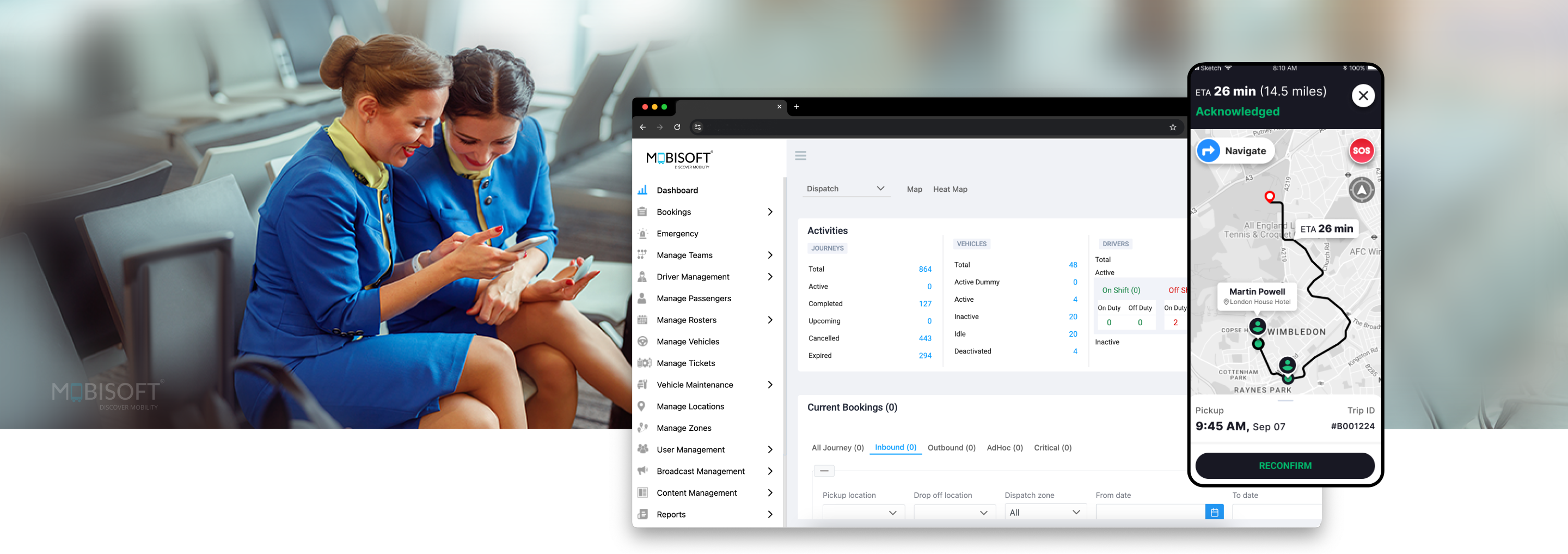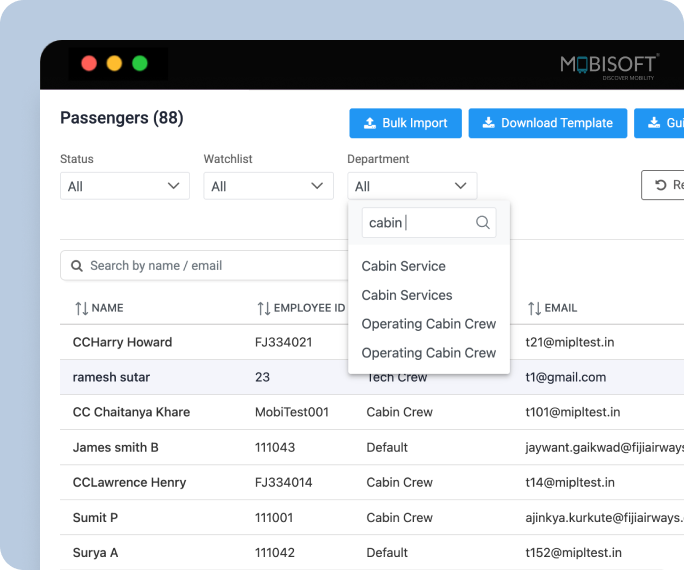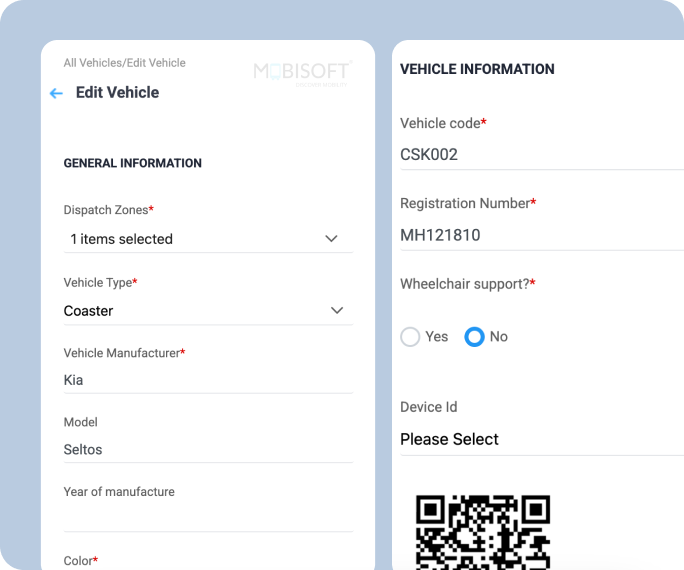Introduction
Managing large-scale operations at an international airport is a challenge in itself. When it comes to transporting air crew reliably across terminals, hotels, and restricted zones, the complexity increases. One of the busiest airports in Southeast Asia partnered with us to overhaul its manual ground aircrew transportation system and replace it with a fully automated, real-time crew transport management system. The result was a smarter, faster, and more scalable operation that significantly improved crew satisfaction and reduced operational delays.
Client Overview
The client is a major international airport hub in Southeast Asia, serving over 40 airlines and handling thousands of airline crew movements every week. The airport operations team was looking to improve the quality, reliability, and speed of its airline crew shuttle services. Their goal was to digitize and automate the entire process, including scheduling, routing, dispatch, and monitoring. They also wanted to reduce human error, improve on-time performance, and optimize resource use.
Key Challenges
Handling crew movements for multiple airlines with varying schedules was a daily operational bottleneck. Each transport request required manual coordination, which left room for frequent miscommunication and missed pickups. With limited technology in place, the system struggled to keep pace with dynamic airport operations.
Key issues included:
- Spreadsheets and phone calls to manage scheduling
- Lack of integration with airline roster systems
- No automation in grouping crew members on the same flights
- Manual vehicle allocation and dispatch
- Delayed pickups, especially during IRROPs (Irregular Operations)
- Low vehicle utilization and high operational overhead
- Inconsistent crew satisfaction and poor service level compliance
These gaps made the system inefficient, costly, and difficult to scale.

The Solution - An End-to-End Air Crew Ground Transportation Automation Platform
We implemented an aviation crew transport solution designed specifically for air crew ground transport management. This AI-powered system replaced all manual tasks with automated workflows and real-time intelligence. The result was a tightly integrated, responsive, and scalable transportation solution capable of handling the unique mobility requirements of airline crew across multiple terminals and airlines. For more information on how this solution can revolutionize crew transport management, you can explore our Airport Crew Transportation Management Solution.
Roster System Integration
To ensure accuracy and reduce manual input, our platform was integrated directly with airline crew management systems. Using secure APIs, the system accessed real-time data on flight schedules, duty rosters, layover details, and hotel arrangements. It also factored in changes like delays or cancellations. This integration enabled dynamic planning and ensured the transport plan always reflected the latest crew status.
Real-time syncing of:
- Flight schedules
- Crew duty rosters
- Layover details and hotel stays
- Delay and cancellation updates

Auto Grouping of Crew Members
Our system automatically grouped crew members based on shared flight times, arrival and departure windows, and gate or terminal locations. It also took layover accommodations into account. This logic-driven grouping reduced the total number of required trips while improving coordination and reducing wait times for the crew.
Automatically group crew members based on:
- Shared flight assignments
- Arrival/departure windows
- Layover accommodations
- Terminal and gate locations

Auto Vehicle Allocation
A dynamic vehicle allocation engine matched the grouped crew members with available vehicles in real-time. The platform considered group size, luggage requirements, SLA priorities, vehicle capacity, and live traffic conditions. This removed the guesswork for dispatchers and improved the efficiency of fleet use, leading to over 30% improvement in fleet utilization rates.
Our dynamic allocation engine considered multiple factors such as:
- Group size & luggage
- Vehicle capacity & availability
- SLA priority (domestic vs. international crew)
- Proximity and current traffic conditions

Auto Dispatch & Live Tracking
Once a group was assigned to a vehicle, the system triggered automated dispatch instructions to drivers through a mobile app. Each driver received real-time updates on pickup schedules, crew details, and GPS navigation optimized for current traffic. A control room dashboard gave dispatchers live visibility into every trip, making it easy to track progress, address exceptions, and ensure SLA compliance.
The system instantly triggered automated dispatch instructions to drivers via a mobile app, including:
- Pickup/drop-off schedule
- Live maps and traffic-aware navigation
- Crew details and contact info
- In-app notifications and two-way communication
Additional Features Delivered
Beyond automation and tracking, the platform included several value-added features. These included automated SMS and app alerts to notify crew members of pickup details, digital trip manifests to support compliance and audits, detailed SLA and performance reports, multi-airline user role access, and offline capabilities for use in restricted zones with limited connectivity.
Implementation Roadmap
The rollout followed a phased approach for maximum efficiency:
- Discovery: Mapped current crew transportation patterns and service level expectations
- Integration: Connected APIs with airline systems for real-time data flow
- App Development: Built native mobile apps for both drivers and dispatchers
- Rollout: Tested across three terminals with over 50 drivers
- Go-Live: Launched 24/7 operations with continuous system optimization
Results and Impact
The transformation delivered immediate and measurable outcomes. Crew transport delays dropped significantly, while dispatcher workloads were reduced. Vehicle usage became more efficient, and the entire operation shifted from reactive to proactive. Most importantly, crew satisfaction improved drastically.
| Metric | Before Automation | After Automation |
|---|---|---|
| Crew Transport Delays | 22% | <5% |
| Dispatcher Coordination Time | 30 min / shift | <5 min / shift |
| Fleet Utilization | 65% | 90%+ |
| Missed Groupings | Frequent | Near Zero |
| Manual Errors in Scheduling | High | <1% |
| Crew Satisfaction Score | 3.5/5 | 4.9/5 |
These results validated the platform’s ability to handle large-scale, high-complexity transport needs with speed and precision.
What Makes This Solution Stand Out
- Fully Automated Workflow from scheduling to dispatch
- Real-Time Flight and Roster Sync for accurate trip planning
- Intelligent Crew Grouping & Routing
- AI-Based Vehicle Allocation
- Multi-Airline & Multi-Terminal Support
- SLA Tracking and Compliance Reporting
- Scalable Architecture for 1000+ daily trips
Client Testimonial

We moved from chaos to control. This automation transformed how we handle air crew transport. Our dispatchers are more productive, drivers are better coordinated, and our crew is finally happy with consistent, on-time pickups.”
Director of Ground Operations,
Southeast Asia International AirportConclusion
By automating air crew ground transportation, the airport moved from a reactive and error-prone process to one driven by real-time intelligence and automation. Every aspect, from crew planning to vehicle dispatch, became more efficient and consistent. The operations team gained better control, the fleet became more productive, and crew members enjoyed timely, coordinated pickups across all terminals.